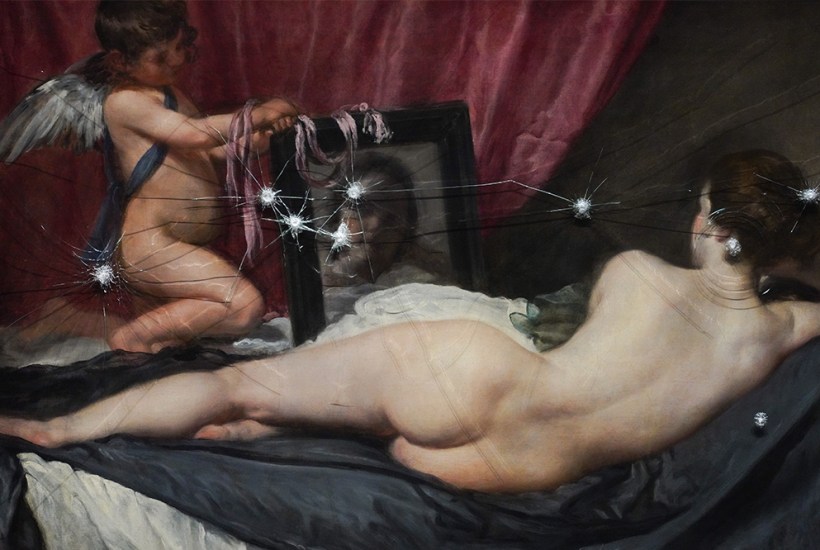There is a stage direction in The Glass Menagerie in which Tennessee Williams describes a tune that will recur through the play. Like a piece of delicately spun glass, he says, it should summon the thought of ‘How beautiful it is and how easily it can be broken’.
I think of that line often. Not least this week when two young protestors from Just Stop Oil took their hammers to the ‘Rokeby Venus’ of Velázquez at the National Gallery. Last year their cohorts threw soup over Van Gogh’s ‘Sunflowers’. Others glued themselves to the frame of another Van Gogh and others still to the frame of Constable’s ‘The Hay Wain’. The culprits responsible for that crime were fined the non-princely sum of £540 each – which was merely the cost of restoration.
If you let such people get away with one thing they will get away with something more, testing the limits each time to see how much they can get away with. So it was with a certain inevitability that these two went at the Velázquez this week with hammers.
Perhaps we are becoming desensitised but I found myself watching them with a combination of rage and resignation. If the National Gallery does not care to protect the national collection, if it cannot be bothered to employ guards who will actually guard the works, or there are not members of the public who will tackle these people, then what exactly is to be done?
Still the sight of these two young people going at it with hammers was quite something. They managed to smash through the protective glass in many places and I suppose we shall see if they have damaged the canvas itself. The pair’s online supporters are pointing out that this is the same canvas that Mary Richardson attacked in 1914 in the name of women’s suffrage. This week’s Velázquez attackers explicitly linked their protest to hers, and inevitably think that they – like her – are on (all together now) the right side of history. What they perhaps do not know is that Ms Richardson went on to join Oswald Mosley’s British Union of Fascists. So perhaps not the perfect role model. But there we are. A little history can go a wrong way.
Funnily enough, the Spanish master has been on my mind of late. I recently finished a seven-country speaking tour with Jordan Peterson, ending with more than 12,000 people joining us at the O2 Arena in London. Not to boast, but in each city we spoke at the biggest arena it had to offer. In Lisbon we were at the bull-fighting ring – the air positively dripping with metaphors. In Malmö we spoke at the ice-skating rink. The thousands of people we talked to each evening were mainly young, diverse in every normal way and hungry for meaning in their lives.
But unlike the members of Just Stop Oil and other such groups, our audiences were not made up of people who wanted to smash things. They were not the sort who would ever dream of destroying something that took so much effort to create. Rather, they are young people who have seen through the apocalyptic cults of our era and the nihilism and anti-human attitudes that are pumped out at them. They seek to find meaning not by destroying – but by making something of their lives. In my experience all the smarter young people are coming this way. Because the woke, the green cultists and others have nothing to offer them other than despair. The cleverer young people want to live lives of hope, not demanding solutions, but finding them.
Which brings me back to Velázquez. Because on the day before we spoke in Madrid, Jordan and I went on a tour of the Prado. I hadn’t been there in 20 years or so, Jordan in a good 40, and while I know that praising the contents of the Prado is like saying ‘This Fifth Symphony by Beethoven is really rather good’, the contents of the Prado really do knock you sideways. We ended up in front of Hieronymus Bosch’s ‘The Garden of Earthly Delights’, which I think it would have taken us about a year, full-time, to even begin to comprehend.
Of course the collection also has some of the greatest Velázquezes anywhere in the world. These include the painting most people reckon to be his masterpiece, ‘Las Meninas’. Like the Bosch, it is a painting you could stand in front of forever and still be left marvelling. What is the figure at the back doing? Who is he? What door is he showing us through, that seems to grow in prominence the further away from the painting you move?
And I remembered from a book I read about the artist some years ago how close we came to losing this painting. In 1734, almost 80 years after Velázquez finished his masterpiece, there was a fire at the Alcazar, now the site of the Royal Palace of Madrid. I recalled the description of the servants and others who realised the catastrophe of the fire and spent their time saving all the treasures they could from the burning building.
The descriptions of their heroism are amazing. They passed the paintings down from the windows of the palace and threw them as the time became short. When they realised that some works, like ‘Las Meninas’, were too large to fit through the fortress-sized windows, they took them out of their frames and hurled them down into hands of others below who took them away to safety.
Why do I say all of this? Because it is a reminder of how beautiful it is and how easily it can be broken. All of us have choices we can make in our lives. One of the most important of all is whether we want to be the sort of person who destroys or the person who creates, the sort of person who burns or the one who saves. Had it not been for a small number of brave Spaniards three centuries ago we would not have ‘Las Meninas’ today. Our era has taught the wrong messages and the wrong heroes. We should teach – and choose – the right ones.
Got something to add? Join the discussion and comment below.
Get 10 issues for just $10
Subscribe to The Spectator Australia today for the next 10 magazine issues, plus full online access, for just $10.
You might disagree with half of it, but you’ll enjoy reading all of it. Try your first month for free, then just $2 a week for the remainder of your first year.















Comments
Don't miss out
Join the conversation with other Spectator Australia readers. Subscribe to leave a comment.
SUBSCRIBEAlready a subscriber? Log in